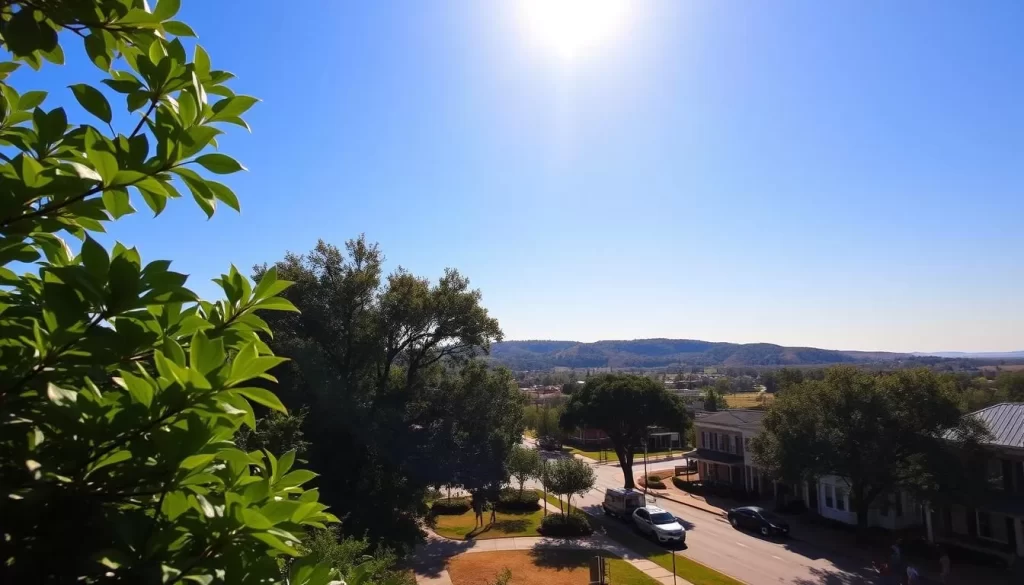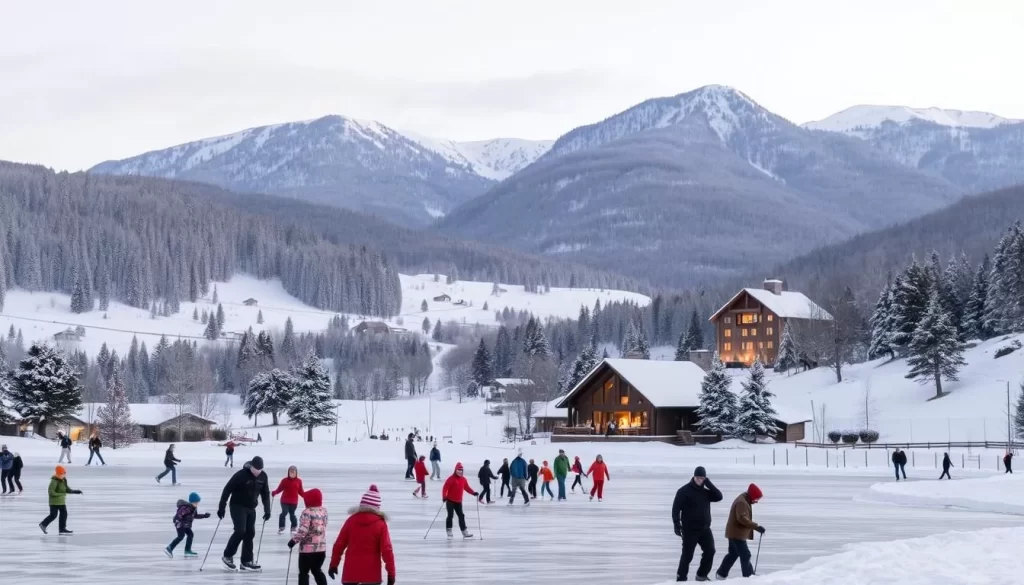✓ Accommodations ✓ Flights ✓ Rental Cars ✓ Tours & Activities
Planning a trip to Georgia can be a delightful experience, given its world-class attractions, ample parks, and award-winning restaurants. To make the most of your trip, understanding the state’s diverse climate patterns is crucial.
The weather in Georgia varies significantly across different seasons, with temperatures and precipitation levels impacting your travel experience. The state’s geographical diversity means that weather conditions differ between coastal areas, mountains, and urban centers like Atlanta.
To ensure you experience the best time to visit, this guide will help you identify the ideal season based on your weather preferences and planned activities. Whether you’re looking for warm beach days or mild temperatures for urban exploration, timing your trip strategically will enhance your overall experience.
Understanding Georgia’s Climate
Understanding Georgia’s climate is essential for planning a trip, as it experiences distinct seasonal changes. The state’s climate varies significantly across different regions, making it crucial to grasp the overall weather patterns to make the most of your visit.
Climate Overview and Annual Patterns
Georgia’s climate is characterized as humid subtropical, with mild winters and hot, humid summers. The state enjoys four distinct seasons, each offering unique experiences for visitors. The annual climate patterns are influenced by its geographical location, with temperatures and precipitation varying across the year.
Temperature and Precipitation Statistics
Atlanta, a major city in Georgia, experiences an average annual temperature of 61°F. The summer temperatures often climb into the high 80s and 90s°F, while winter temperatures are generally mild, with average highs in the 50s°F. Georgia receives an average of 47.12 inches of precipitation annually, spread over 113 days, making it essential to be prepared for rain. The state also sees an average of 2.9 inches of snow annually, primarily in the northern regions.
- The average annual temperature in Georgia is approximately 68°F, with significant seasonal variations.
- Summer is characterized by high temperatures and humidity, with July and August being the hottest months.
- Winters are relatively mild, with temperatures occasionally dipping into the 30s°F.
- The state receives around 50 inches of rainfall annually, with a significant portion occurring during summer thunderstorms.
Best Times to Visit Georgia, United States
When planning a trip to Georgia, United States, understanding the best times to visit can significantly enhance your travel experience. The state’s diverse climate means that the ideal time to visit depends on your preferences and the activities you have planned.
Spring and Fall: The Ideal Seasons
For most visitors, spring (March to May) and fall (September to November) are the best seasons to visit Georgia. During these periods, the temperatures are mild, and the humidity is relatively low, making outdoor activities comfortable. The spring season brings blooming flowers and greenery, while fall offers vibrant foliage. Both seasons are ideal for outdoor adventures and exploring the state’s natural beauty.

Factors to Consider When Planning Your Trip
Several factors should influence your decision on when to visit Georgia. Consider your tolerance for heat and humidity, as summer can be challenging. If you’re on a budget, winter months might be more appealing due to lower accommodation rates. If you are interested in specific events or festivals, research their dates in advance, as many popular celebrations occur during spring and fall.
| Season | Weather | Activities |
|---|---|---|
| Spring | Mild temperatures, blooming flowers | Outdoor adventures, festivals |
| Summer | Hot and humid, frequent rainstorms | Beach visits, summer camps |
| Fall | Comfortable temperatures, foliage | Outdoor activities, harvest festivals |
| Winter | Mild, occasional cold snaps | Holiday celebrations, lower accommodation rates |
Spring in Georgia: March to May
If you’re visiting Georgia in the spring, be prepared for unpredictable weather, with rain showers and temperature changes throughout the day. This season, which spans from March to May, brings a mix of chilly and warm temperatures, making it essential to pack accordingly for your trip.
Weather Conditions and Temperatures
During the spring, Georgia’s weather can be quite varied. In March, you can expect an average high of 65°F and a low of 44°F. April sees a rise in temperatures, with an average high of 73°F and a low of 50°F. By May, the average high temperature reaches 80°F, with lows around 60°F. Early spring can be windy and rainy, so it’s crucial to be prepared for these conditions.
What to Pack for Spring Visits
To make the most of your activities in Georgia during the spring, it’s vital to pack the right gear. Here are some essentials to consider:
- Layers for fluctuating temperatures throughout the day
- Lightweight, breathable clothing for warmer afternoons
- A light jacket or sweater for cooler mornings and evenings
- A compact, packable rain jacket and small umbrella for spring showers
- Comfortable walking shoes for exploring Georgia’s cities and natural attractions
- Hiking boots and moisture-wicking clothing for hiking in north Georgia
- Sun protection (hat, sunglasses, sunscreen) for sunnier days
- Allergy medications for those who need them, due to Georgia’s spring blooms
- A daypack for carrying essentials during your outings
By being prepared for the spring weather in Georgia, you can enjoy your trip to the fullest, regardless of the conditions.
Summer in Georgia: June to August
When summer arrives in Georgia, the heat and humidity can be intense, but with some planning, you can still have a fantastic trip. The summer season, which spans from June to August, is characterized by hot weather and occasional thunderstorms.
Heat, Humidity, and Thunderstorms
Summer in Georgia brings sweltering temperatures, making it essential to stay cool and hydrated. Familiarize yourself with local water parks like Six Flags White Water, where you can enjoy thrilling water rides and escape the heat. Alternatively, take a leisurely stroll through the Atlanta Botanical Garden, appreciating the lush greenery and vibrant blooms. Be prepared for occasional thunderstorms and rain showers by packing a light rain jacket.

Tips for Beating the Summer Heat
To make the most of your summer in Georgia, consider the following tips:
- Plan outdoor activities strategically: Visit attractions during early morning or evening hours when temperatures are more moderate.
- Take advantage of water features: Enjoy Georgia’s coastal beaches, lake swimming areas, and water parks to cool off.
- Schedule indoor activities during peak heat: Explore museums, shopping centers, or historical sites with air conditioning during the hottest part of the day (typically 1-4 PM).
- Stay hydrated: Carry water with you and drink regularly, even if you don’t feel thirsty.
- Dress for the heat: Wear lightweight, light-colored, breathable fabrics to manage heat and humidity.
- Choose accommodations wisely: Opt for places with swimming pools or proximity to water features for refreshing breaks.
- Be flexible: Allow for rest periods during peak heat and be prepared to adjust plans if afternoon thunderstorms develop.
- Utilize shade: Plan routes that maximize time in shaded areas when exploring parks and outdoor attractions.
Fall in Georgia: September to November
As the summer heat dissipates, fall in Georgia brings a refreshing change, making it an ideal time to explore the state’s diverse landscapes and cultural attractions. With fewer crowds and pleasant weather, you can fully experience Atlanta’s charm and enjoy the various activities and events that the season has to offer.
Temperature Ranges and Weather Patterns
During the fall season, Georgia experiences a comfortable temperature range, typically between 50°F and 75°F. This mild climate makes it perfect for outdoor activities such as hiking, visiting historic sites, or simply enjoying the scenic beauty of the nearby Georgia mountains. The weather patterns during this time are generally characterized by clear skies and a gentle breeze, adding to the overall pleasantness of the season.
Fall Foliage and Outdoor Activities
One of the highlights of fall in Georgia is the spectacular foliage display, particularly in the north Georgia mountains where the colors typically peak in late October. You can enjoy fall festivals, visit local vineyards, or take a scenic drive through the countryside. The comfortable temperatures make it an ideal time to explore the state’s many attractions, from historic districts to vibrant neighborhoods like Virginia-Highland and Westside Provisions District in Atlanta.
The season also offers a range of outdoor activities, including hiking in state parks and the Chattahoochee National Forest, and enjoying harvest season at north Georgia’s numerous vineyards. Whether you’re looking for relaxation or adventure, Georgia’s fall season has something for everyone.
Winter in Georgia: December to February
Georgia’s winter season, spanning from December to February, offers a unique blend of holiday cheer and outdoor activities. The state’s mild winter climate makes it an attractive destination for those looking to escape harsher weather conditions.
Mild Winter Climate and Occasional Cold Snaps
During the winter months, Georgia experiences a relatively mild climate compared to other parts of the United States. While it can get chilly, the temperatures are generally manageable, allowing for a variety of outdoor activities. You can enjoy winter in Atlanta by visiting the city’s outdoor ice skating rinks or cozying up with a hot beverage in one of the many local coffee shops.
The mild climate means you can comfortably enjoy outdoor holiday markets and festivals that would be challenging in colder regions. January and February offer the year’s best travel values, with significantly lower accommodation rates and fewer crowds at major attractions.
Winter Activities and Holiday Season
Winter is a great time to experience Georgia’s festive atmosphere, with holiday celebrations throughout December. You can visit the Garden Lights, Holiday Nights at Atlanta’s Botanical Garden, which features 70,000 changing LEDs choreographed to music. Other events include the Chick-Fil-A Peach Bowl, played at the state-of-the-art Mercedes-Benz stadium.
- Enjoy outdoor activities like ice skating or visiting holiday markets.
- Take advantage of lower hotel rates and flight prices after the new year.
- Experience the unique wildlife viewing opportunities, particularly for bird watchers along Georgia’s coast.
- Explore North Georgia’s scenic snow-covered landscapes, such as Brasstown Bald.

Georgia, United States: Best Months for a Weather-Savvy Trip – Monthly Breakdown
Understanding the monthly breakdown of Georgia’s weather is vital for travelers seeking to experience the state at its best. The state’s diverse climate means that the weather varies significantly from month to month.
January through June Weather Specifics
The first half of the year in Georgia brings a range of weather conditions. January and February are typically mild, with average highs in the 50s°F and lows in the 30s°F. As spring begins in March, temperatures gradually rise, with highs reaching the 70s°F by May. June marks the start of summer, with temperatures often in the 80s°F.
- January: Mild winter conditions with average highs in the 50s°F.
- March: Spring begins with gradually rising temperatures.
- June: Summer starts with temperatures in the 80s°F.
July through December Weather Specifics
The second half of the year showcases Georgia’s transition from peak summer heat to mild winter conditions. July and August are the hottest months, with temperatures averaging in the upper 80s to low 90s°F. September brings relief from the summer heat, with temperatures moderating into the low 80s°F. October and November continue the cooling trend, making them ideal for outdoor activities. December brings mild winter conditions, with temperatures typically in the 50s°F during the day.
- July and August: Peak summer heat with high temperatures and humidity.
- September: Relief from summer heat with moderating temperatures.
- October and November: Ideal for outdoor activities with pleasant temperatures.
By understanding the monthly weather breakdown, you can plan your trip to Georgia during the best months for a weather-savvy journey, ensuring a pleasant experience whether you’re visiting Atlanta or exploring the state’s natural beauty.
Must-Attend Events and Festivals by Season
Experience the best of Georgia through its vibrant festivals and events, happening across different seasons. Whether you’re visiting in the spring, summer, fall, or winter, there’s always something exciting to look forward to.
Spring and Summer Events
During the spring and summer months, Georgia comes alive with a variety of events. While specific spring events aren’t detailed, the warm weather sets the stage for outdoor activities and festivals that continue into the summer. Summer is a great time to enjoy events like outdoor concerts and festivals.
As the seasons transition, the events calendar remains packed, ensuring that there’s never a dull moment in Georgia during the spring and summer.
Fall and Winter Celebrations
Fall in Atlanta is a season filled with fantastic festivals such as Music Midtown and the Cabbagetown Chomp & Stomp Chili Cook-off. Music Midtown, a two-day music festival held in September, features a diverse lineup of top artists from various genres. The Cabbagetown Chomp & Stomp Chili Cook-off, held in November, is a celebration of chili, music, and art.

In the winter, Atlanta brings enchanting holiday-themed events. One of the highlights is “Garden Lights, Holiday Nights” at the Atlanta Botanical Garden. Another winter event not to be missed is the Chick-Fil-A Peach Bowl, a college football bowl game held on New Year’s Day.
Some of the notable events include:
- Music Midtown in September, featuring major musical acts.
- The Cabbagetown Chomp & Stomp Chili Cook-off in November, combining culinary competition with bluegrass music.
- North Georgia’s apple harvest festivals in Ellijay and Blue Ridge.
- “Garden Lights, Holiday Nights” at the Atlanta Botanical Garden.
- The Chick-fil-A Peach Bowl on New Year’s Day.
These events provide compelling reasons to visit Georgia during what might otherwise be considered off-season, offering unique experiences and often better travel values, making it a great time to visit.
Best Times to Visit for Specific Activities
The best time to visit Georgia, United States, varies depending on the activities you have planned, from outdoor adventures to cultural experiences. Understanding the climate and seasonal activities can help you plan a more enjoyable trip.
Outdoor Adventures and Nature Exploration
For outdoor enthusiasts, spring (March to May) and fall (September to November) are ideal for hiking, biking, and exploring nature due to the comfortable temperatures and fewer crowds. Summer is perfect for water activities like kayaking and paddleboarding.
Cultural Experiences and Urban Exploration
Visit Atlanta and other cities during the spring and fall for cultural festivals and events. Summer can be hot, but it hosts many outdoor concerts and events. Winter, with its mild climate, is a good time to explore museums and indoor attractions.
Beach and Coastal Activities
Late spring through early fall is best for beach activities, with warm ocean temperatures. Summer offers the fullest beach experience, while fall provides a more relaxed atmosphere with comfortable temperatures.
| Activity | Best Time | Highlights |
|---|---|---|
| Outdoor Adventures | Spring, Fall | Hiking, biking, nature exploration |
| Cultural Experiences | Spring, Fall | Festivals, events, urban exploration |
| Beach Activities | Late Spring to Early Fall | Swimming, kayaking, paddleboarding |
Conclusion
To maximize your experience in Georgia, it’s essential to consider the state’s climate and seasonal events when planning your visit. Georgia offers visitors a diverse climate experience throughout the year, with each season presenting its own unique advantages and considerations for travelers.
Spring (March-May) and fall (September-November) consistently emerge as the best months for a weather-savvy trip to Georgia, offering comfortable temperatures, moderate humidity, and abundant outdoor opportunities. Your ideal time to visit should align with your specific interests, whether that’s experiencing vibrant spring blooms, enjoying summer beach activities, witnessing spectacular fall foliage, or taking advantage of winter’s lower rates and festive atmosphere.
By planning your Georgia trip with weather patterns in mind, you’ll be able to create the perfect itinerary for your visit. Whether you’re exploring Atlanta’s urban attractions, hiking in the north Georgia mountains, or relaxing on the Golden Isles, understanding Georgia’s seasonal patterns will help you pack appropriately and make the most of your trip. Remember that exceptional experiences await in Georgia during every season—the key is matching your visit to your weather preferences and desired activities.
The above is subject to change.
Check back often to TRAVEL.COM for the latest travel tips and deals.






